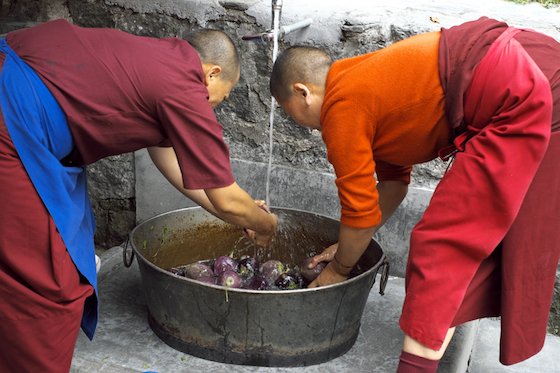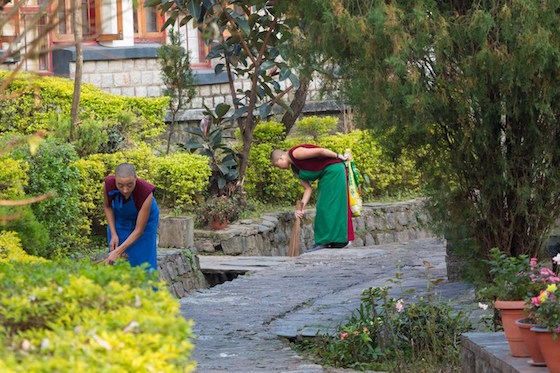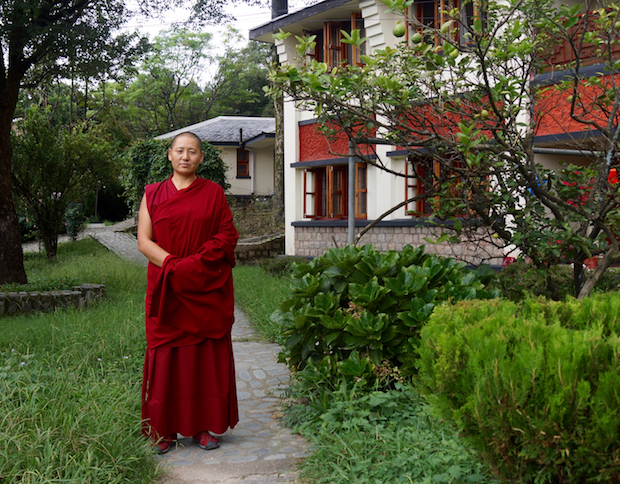In India, the monsoon starts in late June and lasts until September. While the torrential rains are vital for agriculture and bring relief from scorching summer heat, the monsoon can also be deadly, causing floods and landslides. Less disastrously, the monsoon brings daily obstacles to everyone. Here’s how the nuns cope with the challenges of life during the monsoon.
At times this summer, the northern state of Himachal Pradesh, was the rainiest place in India. In August, it was headline news when monsoon rains broke a 60-year record and 292.4 mm of rain (over 11.5 inches) fell in 24 hours in Dharamsala, home of His Holiness the Dalai Lama and location of Geden Choeling Nunnery. The nearby Tibetan Buddhist nunneries of Dolma Ling, Shugsep, and Tilokpur have also been hit by close-to-record rainfalls this summer.
The Challenges of Life During the Monsoon
Here’s a video taken in July 2018 by the Nuns’ Media Team showing the rains at Dolma Ling Nunnery. The deep drainage ditches that weave around and through the nunnery complex to prevent flooding were almost overflowing.

Five of the seven nunneries supported by the Tibetan Nuns Project are located in parts of northern India that receive some of the heaviest rains in the country. Only Sherab Choeling Nunnery in Spiti and Dorjee Zong in Zanskar are spared the monsoon deluges, but they face other problems such as water shortages.
You Need a Good Roof
To cope with the monsoon, you need a good, solid, and well-maintained roof. In the early days of the Tibetan Nuns Project, before new nunneries were built, the nuns who had escaped from Tibet had to camp by the side of the road. The nuns were eventually moved into tents and a series of houses rented by the Tibetan Nuns Project, but the roofs couldn’t always cope with the monsoon rains. Dr. Elizabeth Napper recalls the house used by the Shugsep nuns: “Every available space was filled by a bed; even under the stairs there were beds. The structure was poorly built and rain would run down the walls during the monsoon. It was damp and moldy in there. It was awful.”
Now, thank goodness, all the nuns we support have more solid roofs over their heads. Their dormitories, classrooms, dining halls, kitchens, and libraries can remain dry. However, to remain strong these roofs must be maintained.
In September, we are launching a big project to repair and paint all the metal roofs at Shugsep Nunnery. We need help from our global family of supporters to make this happen. Learn more about the Shugsep Roof Project here. The roof is already rusting in places and, unless the painting is done this fall, the roof will fail.
Wear Plastic Shoes
Puddle jumping is a daily activity during the summer monsoon. There’s no point wearing leather shoes, which will only be destroyed by the damp. To keep one’s feet healthy and as dry as possible, plastic shoes and sandals are essential footwear for the nuns.

Nuns shoes outside of a classroom at Dolma Ling Nunnery on a nice day in May. Photo courtesy of Brian Harris.
The Art of Drying Clothing
One of the biggest challenges of life during the monsoon is laundering and drying clothes. This is true for everyone in India, but the situation for Tibetan Buddhist nuns (and monks) can be even trickier. Nuns and monks are traditionally allowed only two sets of robes so washing and, above all, drying robes during the monsoon is hard. The nuns seize opportunities when the sun is out to hang their robes and other clothing on fences etc. and, during showers, under overhanging balconies. The humidity is so relentless that things just don’t dry.

Nuns’ clothing drying on the nunnery rooftop. Photo courtesy of Olivier Adam
The Challenge of Staying Healthy
Frequent rains make people more vulnerable to illness, especially through exposure to dirty water and the increase in waterborne diseases. During the monsoon, a number of illnesses increase. We are so grateful to the donors who helped with the urgent septic system repairs at both Dolma Ling and Shugsep. The repairs were completed in June before the onset of the monsoon, so this made both nunneries much safer for the nuns. Even so, the nuns must very careful about washing their vegetables during monsoon season to avoid contamination.
Secondly, getting partially wet or totally soaked from the rain water destabilizes your body temperature and makes you vulnerable to sickness. Fungal infections caused by wearing damp clothes and shoes are also a risk.

Nuns washing vegetables. The monsoon rains bring an increase in water-borne illnesses. Photo courtesy of Brian Harris.
Making Friends with Animals and Insects
Just like humans, animals want to get in out of the rain. The nuns sometimes find that they have visitors to their nunneries, such as snakes, spiders, centipedes, and scorpions. Also, all that standing water becomes a perfect breeding ground for mosquitoes, which are vectors for many diseases such as malaria and dengue fever. Dengue fever is communicated through mosquito bites and the most common symptoms are sudden onset of fever, headache, muscle and joint pains, and skin rashes. Some patients also develop symptoms which include vomiting, diarrhoea and loss of appetite.
Previously malaria and dengue have not been a problem for the nuns, but the risk may increase as the climate warms up and the storms become more intense. On August 31 2018, the Hindustan Times reported that so far during this rainy season there have been over 1,500 cases of dengue in the northern Indian state of Himachal Pradesh, the location of five of the seven nunneries we support.
Drainage Ditches Are Essential
Without drainage ditches to channel the water away, the nunneries would be flooded. The nuns work hard year-round to keep these all-important drainage ditches clean and working. One of the projects we’re working on this fall is to improve the drainage in and around the 8 retreat huts at Dolma Ling Nunnery. Some of the Geshema nuns are staying in the retreat huts while taking their two-year course in Buddhist tantric studies. We need to add gutters and drainpipes to the hut roofs huts so that the rainwater does not damage the walls and we need to add drainage ditches all around to prevent flooding. You can learn more about the project here.

The nuns of Dolma Ling Nunnery clean the nunnery paths and drainage ditches daily. Photo courtesy of Dustin Kujawski

